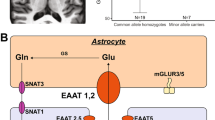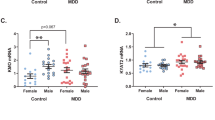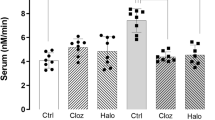Abstract
The kynurenine pathway metabolite kynurenic acid (KYNA), modulating glutamatergic and cholinergic neurotransmission, is increased in cerebrospinal fluid (CSF) of patients with schizophrenia or bipolar disorder type 1 with psychotic features. KYNA production is critically dependent on kynurenine 3-monooxygenase (KMO). KMO mRNA levels and activity in prefrontal cortex (PFC) are reduced in schizophrenia. We hypothesized that KMO expression in PFC would be reduced in bipolar disorder with psychotic features and that a functional genetic variant of KMO would associate with this disease, CSF KYNA level and KMO expression. KMO mRNA levels were reduced in PFC of bipolar disorder patients with lifetime psychotic features (P=0.005, n=19) or schizophrenia (P=0.02, n=36) compared with nonpsychotic patients and controls. KMO genetic association to psychotic features in bipolar disorder type 1 was studied in 493 patients and 1044 controls from Sweden. The KMO Arg452 allele was associated with psychotic features during manic episodes (P=0.003). KMO Arg452 was studied for association to CSF KYNA levels in an independent sample of 55 Swedish patients, and to KMO expression in 717 lymphoblastoid cell lines and 138 hippocampal biopsies. KMO Arg452 associated with increased levels of CSF KYNA (P=0.03) and reduced lymphoblastoid and hippocampal KMO expression (P⩽0.05). Thus, findings from five independent cohorts suggest that genetic variation in KMO influences the risk for psychotic features in mania of bipolar disorder patients. This provides a possible mechanism for the previous findings of elevated CSF KYNA levels in those bipolar patients with lifetime psychotic features and positive association between KYNA levels and number of manic episodes.
This is a preview of subscription content, access via your institution
Access options
Subscribe to this journal
Receive 12 print issues and online access
$259.00 per year
only $21.58 per issue
Buy this article
- Purchase on Springer Link
- Instant access to full article PDF
Prices may be subject to local taxes which are calculated during checkout

Similar content being viewed by others
References
Goldberg JF, Chengappa KN . Identifying and treating cognitive impairment in bipolar disorder. Bipolar Disord 2009; 11 (Suppl 2): 123–137.
Sullivan PF, Kendler KS, Neale MC . Schizophrenia as a complex trait: evidence from a meta-analysis of twin studies. Arch Gen Psychiatry 2003; 60: 1187–1192.
Craddock N, O’Donovan MC, Owen MJ . The genetics of schizophrenia and bipolar disorder: dissecting psychosis. J Med Genet 2005; 42: 193–204.
Lichtenstein P, Yip BH, Björk C, Pawitan Y, Cannon TD, Sullivan PF et al. Common genetic determinants of schizophrenia and bipolar disorder in Swedish families: a population-based study. Lancet 2009; 373: 234–239.
Carlsson A, Lindqvist M . Effect of chlorpromazine or haloperidol on formation of 3methoxytyramine and normetanephrine in mouse brain. Acta Pharmacol Toxicol (Copenh) 1963; 20: 140–144.
Goldstein BI, Kemp DE, Soczynska JK, McIntyre RS . Inflammation and the phenomenology, pathophysiology, comorbidity, and treatment of bipolar disorder: a systematic review of the literature. J Clin Psychiatry 2009; 70: 1078–1090.
Söderlund J, Olsson SK, Samuelsson M, Walther-Jallow L, Johansson C, Erhardt S et al. Elevation of cerebrospinal fluid interleukin-1beta in bipolar disorder. J Psychiatry Neurosci 2011; 36: 114–118.
Guillemin GJ, Kerr SJ, Smythe GA, Smith DG, Kapoor V, Armati PJ et al. Kynurenine pathway metabolism in human astrocytes: a paradox for neuronal protection. J Neurochem 2001; 78: 842–853.
Guillemin GJ, Cullen KM, Lim CK, Smythe GA, Garner B, Kapoor V et al. Characterization of the kynurenine pathway in human neurons. J Neurosci 2007; 27: 12884–12892.
Schwarcz R, Bruno JP, Muchowski PJ, Wu HQ . Kynurenines in the mammalian brain: when physiology meets pathology. Nat Rev Neurosci 2012; 13: 465–477.
Ganong AH, Cotman CW . Kynurenic acid and quinolinic acid act at N-methyl-D-aspartate receptors in the rat hippocampus. J Pharmacol Exp Ther 1986; 236: 293–299.
Birch PJ, Grossman CJ, Hayes AG . Kynurenic acid antagonises responses to NMDA via an action at the strychnine-insensitive glycine receptor. Eur J Pharmacol 1988; 154: 85–87.
Kessler M, Terramani T, Lynch G, Baudry M . A glycine site associated with N-methyl-D-aspartic acid receptors: characterization and identification of a new class of antagonists. J Neurochem 1989; 52: 1319–1328.
Parsons CG, Danyschizophrenia W, Quack G, Hartmann S, Lorenz B, Wollenburg C et al. Novel systemically active antagonists of the glycine site of the N-methyl-D-aspartate receptor: electrophysiological, biochemical and behavioral characterization. J Pharmacol Exp Ther 1997; 283: 1264–1275.
Hilmas C, Pereira EF, Alkondon M, Rassoulpour A, Schwarcz R, Albuquerque EX . The brain metabolite kynurenic acid inhibits alpha7 nicotinic receptor activity and increases non-alpha7 nicotinic receptor expression: physiopathological implications. J Neurosci 2001; 21: 7463–7473.
Linderholm K, Powell S, Olsson E, Holtze M, Snodgrass R, Erhardt S . Role of the NMDA-receptor in Prepulse Inhibition in the Rat. Int J Tryptophan Res 2010; 3: 1–12.
Erhardt S, Engberg G . Increased phasic activity of dopaminergic neurones in the rat ventral tegmental area following pharmacologically elevated levels of endogenous kynurenic acid. Acta Physiol Scand 2002; 175: 45–53.
Nilsson LK, Linderholm KR, Erhardt S . Subchronic treatment with kynurenine and probenecid: effects on prepulse inhibition and firing of midbrain dopamine neurons. J Neural Transm 2006; 113: 557–571.
Olsson SK, Andersson AS, Linderholm KR, Holtze M, Nilsson-Todd LK, Schwieler L et al. Elevated levels of kynurenic acid change the dopaminergic response to amphetamine: implications for schizophrenia. Int J Neuropsychopharmacol 2009; 12: 501–512.
Shepard PD, Joy B, Clerkin L, Schwarcz R . Micromolar brain levels of kynurenic acid are associated with a disruption of auditory sensory gating in the rat. Neuropsychopharmacology 2003; 28: 1454–1462.
Erhardt S, Schwieler L, Emanuelsson C, Geyer M . Endogenous kynurenic acid disrupts prepulse inhibition. Biol Psychiatry 2004; 56: 255–260.
Chess AC, Simoni MK, Alling TE, Bucci DJ . Elevations of endogenous kynurenic acid produce spatial working memory deficits. Schizophr Bull 2007; 33: 797–804.
Olsson SK, Samuelsson M, Saetre P, Lindström L, Jönsson EG, Nordin C et al. Elevated levels of kynurenic acid in the cerebrospinal fluid of patients with bipolar disorder. J Psychiatry Neurosci 2010; 35: 195–199.
Erhardt S, Öberg H, Mathe JM, Engberg G . Pharmacological elevation of endogenous kynurenic acid levels activates nigral dopamine neurons. Amino Acids 2001a; 20: 353–362.
Nilsson LK, Linderholm KR, Engberg G, Paulson L, Blennow K, Lindstrom LH et al. Elevated levels of kynurenic acid in the cerebrospinal fluid of male patients with schizophrenia. Schizophr Res 2005; 80: 315–322.
Erhardt S, Blennow K, Nordin C, Skogh E, Lindstrom LH, Engberg G . Kynurenic acid levels are elevated in the cerebrospinal fluid of patients with schizophrenia. Neurosci Lett 2001b; 313: 96–98.
Schwarcz R, Rassoulpour A, Wu HQ, Medoff D, Tamminga CA, Roberts RC . Increased cortical kynurenate content in schizophrenia. Biol Psychiatry 2001; 50: 521–530.
Sathyasaikumar KV, Stachowski EK, Wonodi I, Roberts RC, Rassoulpour A, McMahon RP et al. Impaired kynurenine pathway metabolism in the prefrontal cortex of individuals with schizophrenia. Schizophr Bull 2011; 37: 1147–1156.
Olsson SK, Sellgren C, Engberg G, Landén M, Erhardt S . Cerebrospinal fluid kynurenic acid is associated with manic and psychotic features in patients with bipolar disorder type I. Bipolar Dis 2012; 14: 719–726.
Nilsson LK, Nordin C, Jonsson EG, Engberg G, Linderholm KR, Erhardt S . Cerebrospinal fluid kynurenic acid in male and female controls—correlation with monoamine metabolites and influences of confounding factors. J Psychiatr Res 2007; 41: 144–151.
Nilsson-Todd LK, Nordin C, Jönsson EG, Skogh E, Erhardt S . Cerebrospinal fluid kynurenic acid in male patients with schizophrenia – correlation with monoamine metabolites. Acta Neuropsychiatrica 2007; 19: 45–52.
Moroni F . Tryptophan metabolism and brain function: focus on kynurenine and other indole metabolites. Eur J Pharmacol 1999; 375: 87–100.
Moroni F, Russi P, Gallo-Mezo MA, Moneti G, Pellicciari R . Modulation of quinolinic and kynurenic acid content in the rat brain: effects of endotoxins and nicotinylalanine. J Neurochem 1991; 57: 1630–1635.
Connick J, Heywood GC, Sills GJ, Thomson GG, Brodie MJ, Stone TW . Nicotinylalanine increases cerebral kynurenic acid content and has anticonvulsant activity. Gen Pharmacol 1992; 23: 235–239.
Chiarugi A, Carpenedo R, Molina MT, Mattoli L, Pellicciari R, Moroni F . Comparison of the neurochemical and behavioral effects resulting from the inhibition of kynurenine hydroxylase and/or kynureninase. J Neurochem 1995; 65: 1176–1183.
Speciale C, Wu HQ, Cini M, Marconi M, Varasi M, Schwarcz R . (R,S)-3,4-dichlorobenzoylalanine (FCE 28833A) causes a large and persistent increase in brain kynurenic acid levels in rats. Eur J Pharmacol 1996; 315: 263–267.
Wonodi I, Stine OC, Sathyasaikumar KV, Roberts RC, Mitchell BD, Hong LE et al. Downregulated kynurenine 3-monooxygenase gene expression and enzyme activity in schizophrenia and genetic association with schizophrenia endophenotypes. Arch Gen Psychiatry 2011; 68: 665–674.
Torrey EF, Webster M, Knable M, Johnston N, Yolken RH . The stanley foundation brain collection and neuropathology consortium. Schizophr Res 2000; 44: 151–155.
Elashoff M, Higgs BW, Yolken RH, Knable MB, Weis S, Webster MJ et al. Meta-analysis of 12 genomic studies in bipolar disorder. J Mol Neurosci 2007; 31: 221–243.
Backlund L, Nikamo P, Hukic DS, Ek IR, Träskman-Bendz L, Landén M et al. Cognitive manic symptoms associated with the P2RX7 gene in bipolar disorder. Bipolar Disord 2011; 13: 500–508.
Wing JK, Babor T, Brugha T, Burke J, Cooper JE, Giel R . SCAN: Schedules for clinical assessment in neuropsychiatry. Arch Gen Psychiatry 1990; 47: 589–593.
Ryden E, Johansson C, Blennow K, Landen M . Lower CSF HVA and 5-HIAA in bipolar disorder type 1 with a history of childhood ADHD. J Neural Transm 2009; 116: 1667–1674.
Sachs GS, Thase ME, Otto MW, Bauer M, Miklowitz D, Wisniewski SR et al. Rationale, design, and methods of the systematic treatment enhancement program for bipolar disorder (STEP-BD). Biol Psychiatry 2003; 53: 1028–1042.
Swartz KJ, Matson WR, MacGarvey U, Ryan EA, Beal MF . Measurement of kynurenic acid in mammalian brain extracts and cerebrospinal fluid by high-performance liquid chromatography with fluorometric and coulometric electrode array detection. Anal Biochem 1990; 185: 363–376.
Yang TP, Beazley C, Montgomery SB, Dimas AS, Gutierrez-Arcelus M, Stranger BE et al. Genevar: a database and Java application for the analysis and visualization of SNP-gene associations in eQTL studies. Bioinformatics 2010; 26: 2474–2476.
Stranger BE, Montgomery SB, Dimas AS, Parts L, Stegle O, Ingle CE et al. Patterns of cis regulatory variation in diverse human populations. PLoS Genet 2012; 8: e1002639.
Nyholt DR . A simple correction for multiple testing for singlenucleotide polymorphisms in linkage disequilibrium with each other. Am J Hum Genet 2004; 74: 765–769.
Gao X, Starmer J, Martin ER . A multiple testing correction method for genetic association studies using correlated single nucleotide polymorphisms. Genet Epidemiol 2008; 32: 361–369.
Barrett JC, Fry B, Maller J, Daly MJ . Haploview: analysis and visualization of LD and haplotype maps. Bioinformatics 2005; 21: 263–265.
Purcell S, Neale B, Todd-Brown K, Thomas L, Ferreira MA, Bender D . PLINK: a tool set for whole-genome association and population-based linkage analyses. Am J Hum Genet 2007; 81: 559–575.
Schwieler L, Erhardt S, Nilsson L et al. Effects of COX-1 and COX-2 inhibitors on the firing of rat midbrain dopaminergic neurons—possible involvement of endogenous kynurenic acid. Synapse 2006; 59: 290–298.
Schwieler L, Linderholm KR, Nilsson-Todd LK, Erhardt S, Engberg G . Clozapine interacts with the glycine site of the NMDA receptor: electrophysiological studies of dopamine neurons in the rat ventral tegmental area. Life Sci 2008; 83: 170–175.
Banerjee J, Alkondon M, Pereira EF, Albuquerque EX . Regulation of GABAergic inputs to CA1 pyramidal neurons by nicotinic receptors and kynurenic acid. J Pharmacol Exp Ther 2012; 341: 500–509.
Linderholm KR, Skogh E, Olsson SK, Dahl ML, Holtze M, Engberg G et al. Increased levels of kynurenine and kynurenic acid in the CSF of patients with schizophrenia. Schizophr Bull 2012; 38: 426–432.
Breton J, Avanzi N, Magagnin S, Covini N, Magistrelli G, Cozzi L et al. Functional characterization and mechanism of action of recombinant human kynurenine 3-hydroxylase. Eur J Biochem 2000; 267: 1092–1099.
Holtze M, Saetre P, Engberg G, Schwieler L, Werge T, Andreassen OA et al. Kynurenine 3-monooxygenase polymorphisms: relevance for kynurenic acid synthesis in patients with schizophrenia and healthy controls. J Psychiatry Neurosci 2012; 37: 53–57.
Aoyama N, Takahashi N, Saito S, Maeno N, Ishihara R, Ji X et al. Association study between kynurenine 3-monooxygenase gene and schizophrenia in the Japanese population. Genes Brain Behav 2006; 5: 364–368.
Holtze M, Saetre P, Erhardt S, Schwieler L, Werge T, Hansen T et al. Kynurenine 3-monooxygenase (KMO) polymorphisms in schizophrenia: an association study. Schizophr Res 2011; 127: 270–272.
Ekelund J, Hennah W, Hiekkalinna T, Parker A, Meyer J, Lonnqvist J et al. Replication of 1q42 linkage in Finnish schizophrenia pedigrees. Mol Psychiatry 2004; 9: 1037–1041.
Hamshere ML, Bennett P, Williams N, Segurado R, Cardno A, Norton N et al. Genomewide linkage scan in schizoaffective disorder: significant evidence for linkage at 1q42 close to DISC1, and suggestive evidence at 22q11 and 19p13. Arch Gen Psychiatry 2005; 62: 1081–1088.
Ayalew M, Le-Niculescu H, Levey DF, Jain N, Changala B, Patel SD et al. Convergent functional genomics of schizophrenia: from comprehensive understanding to genetic risk prediction. Mol Psychiatry 2012; 17: 887–905.
Söderlund J, Schröder J, Nordin C, Samuelsson M, Walther-Jallow L, Karlsson H et al. Activation of brain interleukin-1beta in schizophrenia. Mol Psychiatry 2009; 14: 1069–1071.
Kegel ME, Svensson CI, Erhardt S . IL-1β induces IDO and TDO transcription and provokes the release of kynurenic acid from human astrocytes in vitro. Abstract 240.19/E7, Neuroscience 2011.
Miller CL, Llenos IC, Dulay JR, Weis S . Upregulation of the initiating step of the kynurenine pathway in postmortem anterior cingulate cortex from individuals with schizophrenia and bipolar disorder. Brain Res 2006; 1073-1074: 25–37.
Lappalainen T, Hannelius U, Salmela E, von Dobeln U, Lindgren CM, Huoponen K et al. Population structure in contemporary Sweden—a Y-chromosomal and mitochondrial DNA analysis. Ann Hum Genet 2009; 73: 61–73.
Humphreys K, Grankvist A, Leu M, Hall P, Liu J, Ripatti S et al. The genetic structure of the Swedish population. PLoS One 2011; 6: e22547.
Kocki T, Wielosz M, Turski WA, Urbanska EM . Enhancement of brain kynurenic acid production by anticonvulsants—Novel mechanism of antiepileptic activity? Eur J Pharmacol 2006; 541: 147–151.
Ceresoli-Borroni G, Rassoulpour A, Wu HQ, Guidetti P, Schwarcz R . Chronic neuroleptic treatment reduces endogenous kynurenic acid levels in rat brain. J Neural Transm 2006; 113: 1355–1365.
Heyes MP, Chen CY, Major EO, Saito K . Different kynurenine pathway enzymes limit quinolinic acid formation by various human cell types. Biochem J 1997; 326 (Pt 2): 351–356.
Guillemin GJ, Smythe G, Takikawa O, Brew BJ . Expression of indoleamine 2,3-dioxygenase and production of quinolinic acid by human microglia, astrocytes, and neurons. Glia 2005; 49: 15–23.
Acknowledgements
We thank Dzana Hukic, Inger Römer Ek, Martina Wennberg, Agneta Carlswärd-Kjellin, Stina Stadler and Emarndeena Haji Cheteh for assistance. For microarray data, we acknowledge Stanley Medical Research Institute and Drs Bahn, Kato, Vawter, Young, Dobrin and Altar (Supplementary Text S2). This project was funded by Karolinska Institutet, Stockholm County Council (ALF), Swedish Research Council, Söderström-Königska Foundation, Royal Physiographic Society in Lund, Fredrik and Ingrid Thuring Foundation, Åhléns-stiftelsen and Psychiatry Southwest, Stockholm. The research was further supported by the William Lion Penzner Foundation (Department of Psychiatry and Human Behavior, University of California, Irvine), and NIMH Grant R01MH085801 (MPV).
Author information
Authors and Affiliations
Corresponding author
Ethics declarations
Competing interests
The authors declare no conflict of interest.
Additional information
Supplementary Information accompanies the paper on the Molecular Psychiatry website
PowerPoint slides
Rights and permissions
About this article
Cite this article
Lavebratt, C., Olsson, S., Backlund, L. et al. The KMO allele encoding Arg452 is associated with psychotic features in bipolar disorder type 1, and with increased CSF KYNA level and reduced KMO expression. Mol Psychiatry 19, 334–341 (2014). https://doi.org/10.1038/mp.2013.11
Received:
Revised:
Accepted:
Published:
Issue Date:
DOI: https://doi.org/10.1038/mp.2013.11
Keywords
This article is cited by
-
Kynurenine pathway and its role in neurologic, psychiatric, and inflammatory bowel diseases
Molecular Biology Reports (2023)
-
Psychotic features, particularly mood incongruence, as a hallmark of severity of bipolar I disorder
International Journal of Bipolar Disorders (2022)
-
The tryptophan catabolite or kynurenine pathway in schizophrenia: meta-analysis reveals dissociations between central, serum, and plasma compartments
Molecular Psychiatry (2022)
-
The kynurenine pathway: a finger in every pie
Molecular Psychiatry (2020)
-
Serum Metabolic Profiles of the Tryptophan-Kynurenine Pathway in the high risk subjects of major depressive disorder
Scientific Reports (2020)



